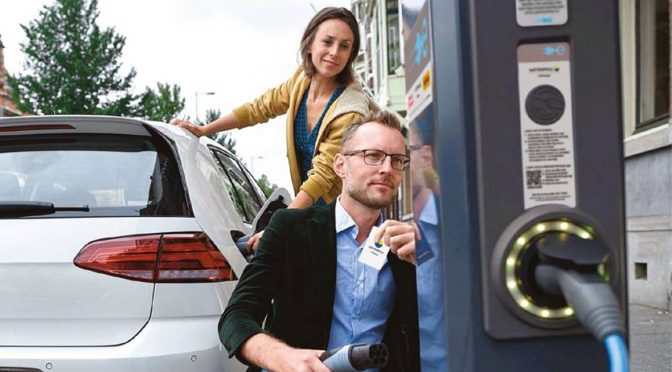Some 80 public charging stations owned by a number of Dutch municipalities have now been equipped with innovative software that controls the charging speed for electric vehicles according to the supply of electricity.
In the coming years, still more of the electricity in the electricity grid will come from sun and wind, but the challenge is that the supply of these two energy sources fluctuates with the actual weather conditions. On sunny days with strong wind there is a large supply, while at other times there is much less. With the Green Charging system, the amount of electricity available determines how fast vehicles are charged. When the available amount of electricity is high, vehicles are charged at maximum speed, while the charging speed is temporarily reduced, if the supply drops, for instance due to less wind. This way drivers of electric vehicles help to accommodate the fluctuations in electricity supply allowing a higher proportion of renewable energy in the system. The participating municipalities are keen to promote this development and have made 80 charging stations available for the pilot project.

Tomas Björnsson, head of Vattenfall e-mobility
“Sustainable charging is vital for sustainable driving of electric vehicles. And systems, like the one we are introducing now, are a crucial development for the energy transition and for achieving our and society’s goals for air quality and the climate”, says Tomas Björnsson, head of Vattenfall e-mobility. “Through this pilot, we want to showcase that by combining our InCharge charging services and our trading services, we can facilitate a better utilisation of the grid, just as drivers of electric vehicles can potentially look forward to lower tariffs in the longer term”.
Smart innovation
The trick here is that the software developed by Vattenfall basically links the charging stations to the so-called imbalance market (see box), where the amount of electricity generated and consumed is precisely monitored. Every fifteen minutes the charging software checks how much electricity is available and adjusts the capacity of the charging stations accordingly.

Erik Suichies, Head of BU Customers in Business Area Markets
“For the car driver, this flexible charging capacity is good, as the charging is done when prices are low. And flexibility is becoming still more important in order to keep a stable grid,” says Erik Suichies, Head of BU Customers in Business Area Markets. “Flexible charging based on price predictions of the imbalance market will help stabilise the grid and by utilising the grid better and avoiding peak loads, the charging system creates room to add more of the fluctuating renewable energy sources to the grid. Over the coming years the Dutch market is expected to grow to two million electric cars and this pilot is yet another step towards accommodating so many cars in the system and allowing fossil-free living within one generation.”
Electric vehicle drivers benefit without noticing
Drivers of electric vehicles naturally want to be able to rely on always starting off with a fully charged battery. That is why the software has built in restrictions. For example, charging always takes place at maximum capacity for the first 30 minutes, and the capacity is never reduced for more than 30 minutes during a three-hour period. This way electric vehicle drivers hardly notice the effects of smart charging, but they will save money in the long term as the Green Charging system avoids periods when less power is generated and electricity is therefore more expensive.
Charging pilot projects in the Netherlands and Germany
Green Charging is one of three pilots run in the Netherlands and Germany.
Tomas Björnsson explains: “Vattenfall holds the concession for public charging of electric cars in Amsterdam. Here we are operating more than 3,500 charging points of which around 900 are included in our so-called Flexpower project, where we steer the charging stations based on daily load curves from the grid operator and forecasts for local neighbourhood solar panel production. At times when the general demand peaks in an area, the grid operator instructs us to scale down on the output delivered by our charging points – especially if at the same time the local solar panels are not delivering sufficient power.”
In Berlin, Vattenfall and Berlin Waste Management (BSR), which is responsible for waste management for two million households in the city, are carrying out another pilot project for flexible charging of BSR’s 80 electric vehicles. Vattenfall is optimising the charging by steering it to times when prices are low, i.e. especially when there is high wind and solar power generation and demand is low.
“These pilots give a flavour of the kind of services that will be available to electric vehicle drivers and reduces cost for the end consumer without impacting the quality of services and customer experience,” Tomas Björnsson concludes.
This is how the imbalance market works:
In the energy market all parties have to hand in plans to the Transmission System Operator stating how much they produce or consume. If their actual production or consumption differs from this plan, they create an imbalance in the energy system. These imbalances are handled by the TSOs with the help of the imbalance market to stabilise the grid. With more flexible production added to the energy system, deviations from the planned against actual production will increase and thus the need to add also more flexible consumption to the system.
Municipalities participating in the Green Charging pilot project
Green Charging is a cooperation between Vattenfall, Dutch MRA-Elektrisch and eleven municipalities: Aalsmeer, Alkmaar, Amstelveen, Bergen NH, Edam-Volendam, Heemskerk, Huizen, Nieuwegein, Oostzaan, Ouder-Amstel and Zaanstad.


